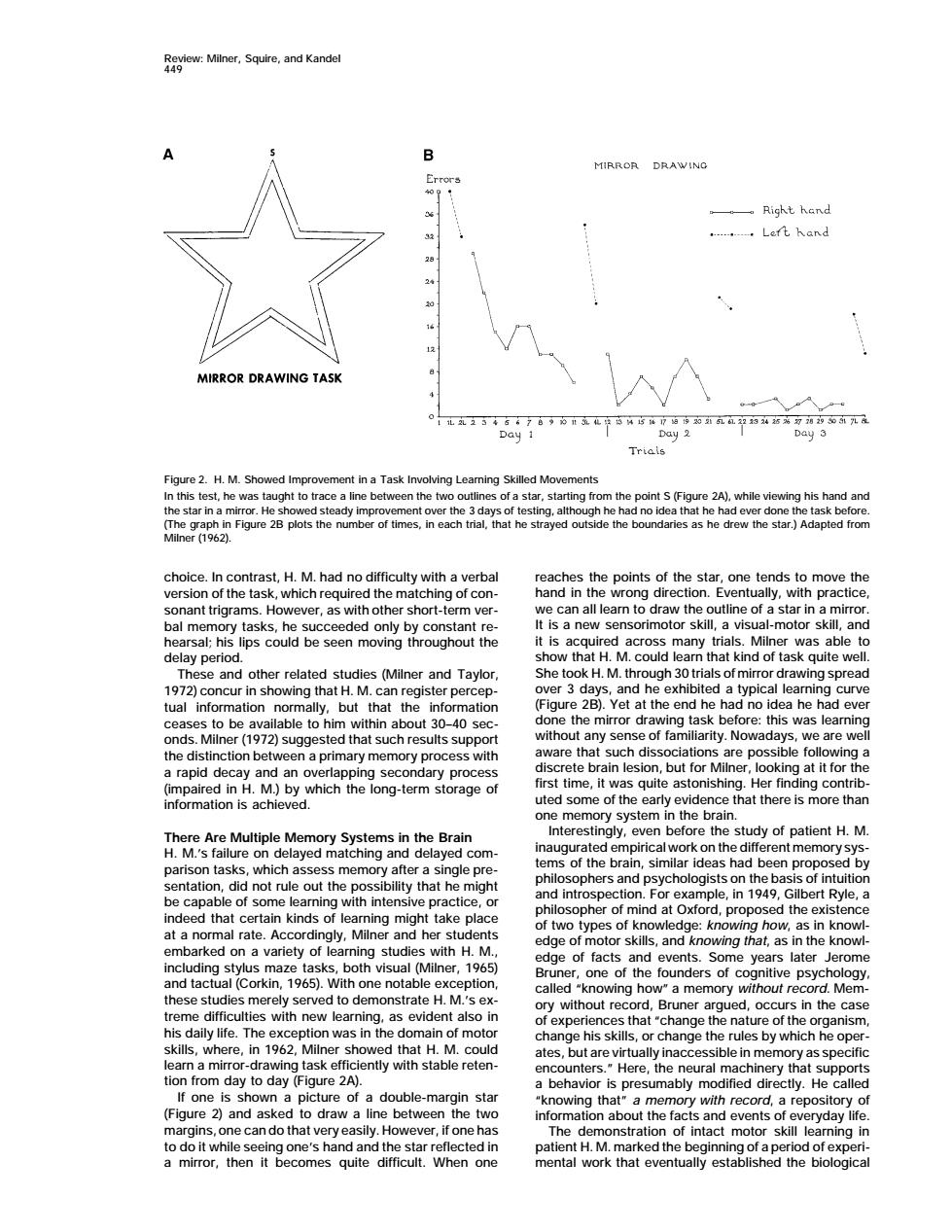正在加载图片...

w:Mner.qure,and and MIRROR DRAWING Bicht.hend Lert hand MIRROR DRAWING TASK ay Figure2.H.M.Showed Improvement ina Task Involving Leaming Skiled Move ents choice.In contrast.H.M.had no difficulty with a verba aches the ints of the star one tends to m version ofthe task, in ion. n p ry tasks, a ne rimo skil delayperio ng through could le hat kind of ask quite ver 3 ys,and he exhi 20A0 ing task re:this v at such res e that such diss a rapid decay and an oare pos ary proces mation sachi ng-term te astonishing torage first time,it w vas qui Her finding cor brain There Are Multiple Men ory Systems in the Brain npiricalwork t mem e01 delayed matc that h migh s and psychol s of ir n kinds ming might osopherofmind ed the doe of with H.M skills,and embarked on a variety of na studies and tactual (corkin.1965).With one of the rd Br daily life.The M his skill ge the which hoo wing task ently with stable reten the noural one is ictu of a double-margin star nfo ut the rains necando that easily H er i of intact mo onReview: Milner, Squire, and Kandel 449 Figure 2. H. M. Showed Improvement in a Task Involving Learning Skilled Movements In this test, he was taught to trace a line between the two outlines of a star, starting from the point S (Figure 2A), while viewing his hand and the star in a mirror. He showed steady improvement over the 3 days of testing, although he had no idea that he had ever done the task before. (The graph in Figure 2B plots the number of times, in each trial, that he strayed outside the boundaries as he drew the star.) Adapted from Milner (1962). choice. In contrast, H. M. had no difficulty with a verbal reaches the points of the star, one tends to move the version of the task, which required the matching of con- hand in the wrong direction. Eventually, with practice, sonant trigrams. However, as with other short-term ver- we can all learn to draw the outline of a star in a mirror. bal memory tasks, he succeeded only by constant re- It is a new sensorimotor skill, a visual-motor skill, and hearsal; his lips could be seen moving throughout the it is acquired across many trials. Milner was able to delay period. show that H. M. could learn that kind of task quite well. These and other related studies (Milner and Taylor, She took H. M. through 30 trials of mirror drawing spread 1972) concur in showing that H. M. can register percep- over 3 days, and he exhibited a typical learning curve (Figure 2B). Yet at the end he had no idea he had ever tual information normally, but that the information ceases to be available to him within about 30–40 sec- done the mirror drawing task before: this was learning onds. Milner (1972) suggested that such results support without any sense of familiarity. Nowadays, we are well aware that such dissociations are possible following a the distinction between a primary memory process with discrete brain lesion, but for Milner, looking at it for the a rapid decay and an overlapping secondary process first time, it was quite astonishing. Her finding contrib- (impaired in H. M.) by which the long-term storage of uted some of the early evidence that there is more than information is achieved. one memory system in the brain. Interestingly, even before the study of patient H. M. There Are Multiple Memory Systems in the Brain inaugurated empirical work on the different memory sys- H. M.’s failure on delayed matching and delayed com- tems of the brain, similar ideas had been proposed by parison tasks, which assess memory after a single pre- philosophers and psychologists on the basis of intuition sentation, did not rule out the possibility that he might and introspection. For example, in 1949, Gilbert Ryle, a be capable of some learning with intensive practice, or philosopher of mind at Oxford, proposed the existence indeed that certain kinds of learning might take place of two types of knowledge: knowing how, as in knowl- at a normal rate. Accordingly, Milner and her students edge of motor skills, and knowing that, as in the knowl- embarked on a variety of learning studies with H. M., edge of facts and events. Some years later Jerome including stylus maze tasks, both visual (Milner, 1965) Bruner, one of the founders of cognitive psychology, and tactual (Corkin, 1965). With one notable exception, called “knowing how” a memory without record. Memthese studies merely served to demonstrate H. M.’s ex- ory without record, Bruner argued, occurs in the case treme difficulties with new learning, as evident also in of experiences that “change the nature of the organism, his daily life. The exception was in the domain of motor change his skills, or change the rules by which he operskills, where, in 1962, Milner showed that H. M. could ates, but are virtually inaccessible in memory as specific learn a mirror-drawing task efficiently with stable reten- encounters.” Here, the neural machinery that supports tion from day to day (Figure 2A). a behavior is presumably modified directly. He called If one is shown a picture of a double-margin star “knowing that” a memory with record, a repository of (Figure 2) and asked to draw a line between the two information about the facts and events of everyday life. margins, one can do that very easily. However, if one has The demonstration of intact motor skill learning in to do it while seeing one’s hand and the star reflected in patient H. M. marked the beginning of a period of experia mirror, then it becomes quite difficult. When one mental work that eventually established the biological